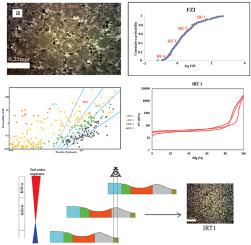Journal of African Earth Sciences ( IF 2.3 ) Pub Date : 2021-03-30 , DOI: 10.1016/j.jafrearsci.2021.104203 Maziyar Nazemi , Vahid Tavakoli , Hossain Rahimpour-Bonab , Masoud Sharifi-Yazdi

|
In this research, an integrated geological and petrophysical approach was applied to understanding the most critical factors affecting the water saturation exponent in the Permian–Triassic Kangan and Dalan carbonate formations in the central Persian Gulf in Iran. Economically, water saturation has a fundamental role in reservoir characterisation. A total of 8 sedimentary facies were recognised with multiple diagenetic phases. Diagenetic processes include marine cementation, moldic dissolution, early dolomitisation, recrystallisation, anhydrite cementation, compaction, and fracturing, which have influenced reservoir properties. Four third-order sequences were distinguished in the study area accompanied by nine fourth-order sequences. Petrographic analysis, scanning electron microscopy, petrophysical core analysis, wireline log data as well as mercury injection tests integrated through flow zone indicator, Lucia classes, and Lorenz plot approaches. Consequently, 4 integrated rock types (IRTs) were identified with particular depositional and diagenetic features. IRT1 with dominant interparticle pore type and strong porosity–permeability correlation (average 9.1% porosity and 27 mD permeability, R2 = 0.98), has a high saturation exponent (n = 2.2). IRT4 with grain-to mud-dominated facies, low porosities (average 1.4%), and a mean value of 4.54 mD permeability has the lowest saturation exponent (n = 1.07). Moldic dissolution with low pore connectivity is the dominant pore type in IRT2 and IRT3 which have a medium and relatively high saturation exponent, respectively (IRT2 n = 1.53 and IRT3 n = 1.78). Accordingly, a conceptual model was suggested for saturation exponent variations in a high-frequency sequence stratigraphic framework. In order to evaluate the heterogeneity of the studied formations and its impact on the reservoir properties, the characteristics of the determined rock units were studied. This study integrates microscopic to macroscopic geological and petrophysical factors to understand the saturation exponent distribution in a heterogeneous carbonate reservoir, leading to obtaining a more accurate water saturation estimation of such reservoirs.
中文翻译:

在地质框架中将岩石物理属性与饱和度数据整合在一起,即波斯湾中部的二叠纪-三叠纪油藏
在这项研究中,采用了综合的地质和岩石物理方法来理解影响伊朗中部波斯湾的二叠纪-三叠纪康安和达兰碳酸盐岩层中水饱和指数的最关键因素。从经济上讲,含水饱和度在储层表征中起着根本性的作用。共有8个沉积相被识别为多个成岩相。成岩过程包括海相固井,霉菌溶解,早期白云石化,再结晶,硬石膏胶结,压实和压裂,这些都影响了储层的性质。在研究区域中区分出四个三阶序列,并伴有九个四阶序列。岩相分析,扫描电子显微镜,岩石物理核心分析,电缆测井数据以及通过流动区指示器,Lucia类和Lorenz绘图方法集成的汞注入测试。因此,确定了4种具有特殊沉积和成岩特征的综合岩石类型(IRT)。IRT1具有主要的颗粒间孔隙类型和强的孔隙度-渗透率相关性(平均孔隙度为9.1%,渗透率为27 mD,R 2 = 0.98),具有较高的饱和指数(n = 2.2)。具有颗粒到泥浆为主的相,低孔隙度(平均1.4%),渗透率平均值为4.54 mD的IRT4的饱和指数最低(n = 1.07)。具有低孔隙连通性的霉菌溶解是IRT2和IRT3的主要孔隙类型,分别具有中等和相对较高的饱和指数(IRT2 n = 1.53和IRT3 n = 1.78)。因此,提出了高频层序地层框架中饱和指数变化的概念模型。为了评估所研究地层的非均质性及其对储层物性的影响,对确定的岩石单元的特征进行了研究。



























 京公网安备 11010802027423号
京公网安备 11010802027423号